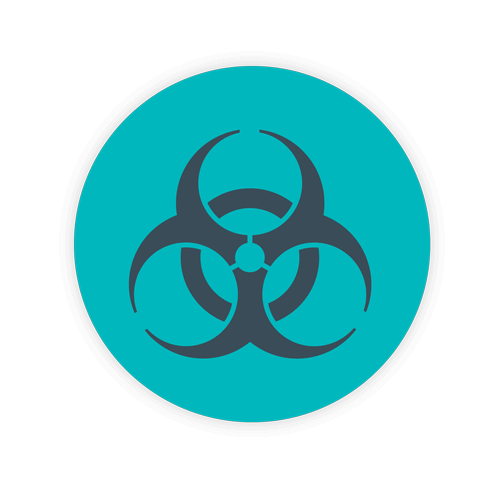Guide to New Mexico Medical Waste Regulations

New Mexico, otherwise known as the “Land of Enchantment” is home to more than two million residents who occasionally need emergency and ongoing care. The state is also home to nearly 40 hospitals and dozens of outpatient and urgent care facilities, cancer treatment centers, dental offices, and veterinary services. Many of the states healthcare’s facilities are located in Albuquerque and the state’s capital city of Santa Fe. In addition, Indian Health Service facilities provide health care services throughout the vast, rural regions of the state.
Each of these types of facilities produce medical waste, some in urban areas, others extremely rural. Regardless of location and size, each healthcare facility is responsible for compliant medical waste disposal processes that protect not only healthcare professionals, but patients and the environment.
TOPICS WE WILL COVER:
1 / Who makes the rules in New Mexico?
2 / Hazardous waste pharmacueticals
3 / Generators and e- manifests
4 / Waste disposal in New Mexico
Who makes the rules in New Mexico?
Regulations for compliant healthcare waste segregation and disposal falls under the guidelines of the New Mexico Environment Department’s Solid Waste Bureau, the Hazardous Waste Bureau, and the state’s Administrative Codes in regard to biomedical waste and biomedical waste combustion. Rules also adhere to the guidelines of federal governmental agencies such as the Environmental Protection Agency (EPA), the U.S. Dept. of Transportation (DOT and New Mexico DOT), and the Occupational Safety and Health Administration (OSHA).
Definitions are important when it comes to not only understanding, but following regulations. Two very important definitions when it comes to medical waste management in the state refer to anatomical/pathological waste, and biomedical waste. Often, the two are used interchangeably.
New Mexico’s Administrative Code 20.2.6 3.7 provides specific definitions of each:
Anatomical/pathological waste defines “human or animal remains consisting of carcasses, tissues, organs or body parts that may or may not be infectious.”
Biomedical waste defines “waste that includes anatomical/pathological wastes, infectious wastes and chemotherapeutic wastes. Incorporated in this definition are wastes generated in healthcare facilities, medical laboratories, and veterinary clinics that require special handling.”
Chemotherapy waste implies “waste resulting from the production or use of antineoplastic agents used for the purpose of stopping or reversing the growth of malignant cells. Chemotherapeutic wastes shall not include any waste containing antineoplastic agents that are listed as hazardous waste.”
It’s important for all healthcare waste generators within the state to carefully review definitions and specifics when it comes to regulations in order to ensure compliance. The same is true for keeping up-to-date on regulations, new rulings, and amendments.
For example, the Hazardous Waste Bureau promotes the New Generator Rule of the Environmental Improvement Board, the primary authority for hazardous waste regulations in the state. The New Generator Rule adopts recent federal guidelines that have been incorporated into New Mexico’s Administrative Code under the topic of “Hazardous Waste Management Regulations 20.4.1). The rule is applicable to any person, facility, or business that generates, stores, transports, or disposes of hazardous waste. The rule went into effect in December 2018. The purpose of the rule was to establish standards for more compliant identification and listing of hazardous wastes for generators and transporters of such waste.
Every waste generator should be familiar with New Mexico’s statutes in regard to solid wastes, procedures, permits, as well as federal regulations and guidance, which New Mexico also implements under Title 40 Code of Federal Regulations. Generators cannot pick and choose between the two. Both must be followed.
Hazardous waste pharmaceuticals
New Mexico’s Environment Department publishes a fact sheet regarding hazardous waste pharmaceuticals, including identification and management. It should be noted that guidelines for any facility dealing with pharmaceutical waste that might even be potentially hazardous refer to 40 CFR Part 261, subparts C and D for listings of hazardous waste or those that include concentrations and ingredients that may cause the pharmaceutical to be deemed hazardous.
Characteristics common to hazardous pharmaceutical waste include toxicity, ignitability, and corrosivity. Specific questions regarding hazardous waste pharmaceuticals can always be directed to the New Mexico Environment Department’s Hazardous Waste Bureau.
Generators and e-manifests
In 2018, the EPA created a nationally recognized system for the electronic tracking of hazardous waste shipments from a waste generator to the ultimate disposal site. The system was designed to further enhance the cradle-to-grave approach to healthcare waste management. While paper manifests can still be used in the state, e-manifests are encouraged by the EPA.
How do these manifests affect generators? Every hazardous waste generator will require an EPA identification number and must register and comply with the requirements for record-keeping found in 40 CFR part 262. The manifest must accompany shipments of hazardous waste and any regulated waste.
Healthcare waste generators that produce hazardous waste can access the required form from the Office of Resource Conservation Recovery. Fill out EPA Site Identification Form 8700-12 or EPA form 8700-23, whichever is applicable.
Waste disposal in New Mexico
It should be noted that per New Mexico Article 8 (Solid Waste Incineration) that solid waste “shall not be disposed of by incineration in New Mexico until the Environmental Improvement Board adopts regulations.” However, according to New Mexico Statute 74-8-3 (under exemptions), the laws state that “medical waste incinerators incinerating less than three tons per day in medical waste incinerators that were in operation as of July 1, 1989, are exempt from the provisions of sections 74-8-1 and 74-8-2 (New Mexico statutes annotated 1978).”
Article 4 of New Mexico’s Statutes found under Chapter 74 (Environmental Improvement) provides detailed information regarding hazardous wastes. While some of the laws and regulations can be confusing, it’s important for all waste generators to make an effort to research not only federal guidelines, but the statutes and regulations of the state of New Mexico. Resist the urge to skim over such guidelines to avoid penalties and fines assessed for non-compliance.
New Mexico’s Administrative Code 20.2.6 3.201 (under General Requirements) states that hazardous wastes are not allowed to be combusted in a combustion unit subject to this regulation unless a permit to do so has been received following the guidelines of RCRA and has been obtained from the New Mexico Department’s Hazardous Waste Bureau.
Refer to New Mexico’s solid waste management regulations (20.9.1) when dealing with infectious wastes, which, in New Mexico are defined as special wastes.
Any biomedical waste combustion unit that is located at a facility with the capability of handling up to 50 tons per day must meet the requirements of New Mexico’s Administrative Code 20.2 .62 regarding municipal waste combustion.
Turn to Daniels for medical waste management guidance in New Mexico
With decades of experience in the healthcare waste management industry, Daniels Health stays up-to-date with federal as well as state guidelines for compliant medical waste segregation, storage, transportation and disposal. We understand that finding and reviewing state and federal laws is time-consuming and often confusing. However, compliance is key, not only in preventing damage to reputation and incurring massive fines and penalties, but in protecting the general population as well as the environment. For more information on cost-effective and sustainable healthcare waste management systems, products, and services, call Daniels Health today.
Let's Talk!
Your time is valuable, and we don’t want to play hard to get. You can either phone us directly on the details listed on our contact page, or feel free to fill out this short form and one of our team members will get back to you as quickly as possible.
